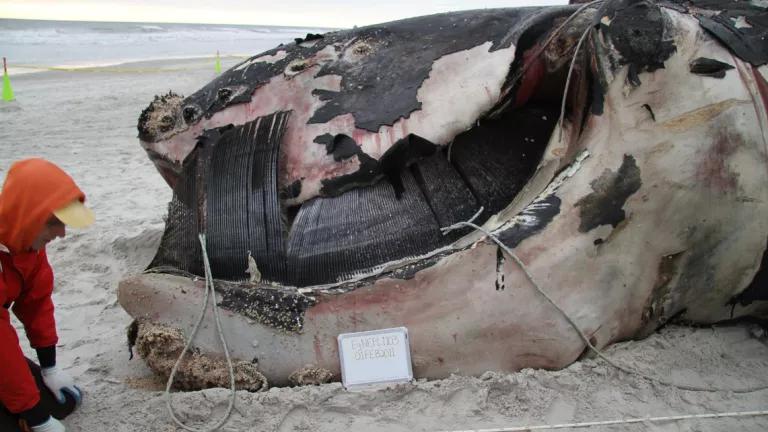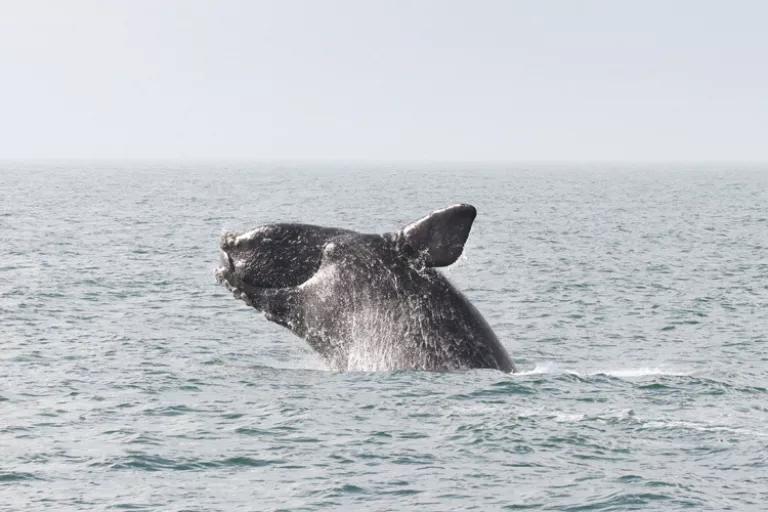
“As scientists we call on Maine, together with all New England states and their representatives, to provide their full support for NOAA’s efforts to develop and implement new, effective, and science-based risk-reduction measures that will protect both whales and fishermen from the serious risks they both face.”
Eighteen scientists with leading expertise on North Atlantic right whales have set the record straight on the level of risk that the species faces in Maine waters from entanglement in fishing gear.
The scientists criticize recent efforts by Maine to delay or suspend the development of new fishing regulations critical the right whale’s survival, in a letter addressed to Senator Susan Collins, cc’ing Maine’s congressional delegation and governor, the Maine Lobstermen’s Association—which recently withdrew its support for the April 2019 Atlantic Large Whale Take Reduction Team proposal for new conversation measures. The letter also cc’ed the Maine Department of Marine Resources, the Atlantic Large Whale Take Reduction Team, several representatives from NOAA fisheries, and several press outlets.
The scientists correct three main points of mis-information shared by Maine congressional delegation and lobster industry. They conclude that: “the number of North Atlantic right whales in Maine waters, the number of entanglements that are occurring in Maine waters, and severity of all entanglements and their effects upon the right whale population are all significantly underestimated.”
Debunking the Maine Myths with Facts
1. Right whales are common in both Maine and U.S. waters
Right whales have been observed in Maine lobster management zones during every month of the year, sometimes in significant numbers. These observations are likely a significant underestimate of the number of whales present, as systematic visual or acoustic surveys have not been conducted in recent years. Due to long dive times and lack of noticeable dorsal fin, it is entirely possible that most fishermen have never seen a right whale in Maine waters, but that does not mean they are absent.
Also, not all right whales are migrating to Canada. Only 130 to 150 right whales have been sighted in the Gulf of St. Lawrence in Canada in recent years, meaning that approximately two thirds of the population are occurring elsewhere, many of them in U.S. waters. Also, to get to Canadian waters, right whales necessarily travel through the Gulf of Maine during their annual migration.
Because right whales are difficult to see, are distributed unpredictably, and because Maine waters have high concentrations of the right whale’s primary prey and have not been subject to systematic surveys in recent years, the numbers of North Atlantic right whales that occur in Maine waters are likely significantly underestimated by fishermen and managers.
2. Lobster trap density and location mean that entanglement in Maine waters is a key concern
Combined, high lobster trap density and simultaneous whale occurrence will lead to entanglements in any part of the ocean. Right whales are demonstrably occurring in Maine lobster fishing zones, and 87 percent of the U.S. Atlantic lobster fishery falls with Maine waters—representing about 3 million licensed traps and approximately 400,000 vertical lines. Every single vertical line poses an entanglement risk.
Few entanglements have been definitively tracked to Maine fisheries because it is extremely rare to identify the origin of gear to any fishery. Also, due to previous actions of the Maine’s elected officials, 70 percent of Maine’s waters are entirely exempt from regulations requiring gear to be marked with country and state of origin. This means it is not currently possible to determine if right whale entanglements originated in Maine. Even with these challenges, from 1997-2017, three right whale entanglements were definitively traced to the Maine coastal lobster fishery, and three more to the offshore fisheries off Maine.
The high trap counts, the current gear marking scheme, and the challenges on both recovering and identifying fishing gear of any kind, combine to significantly underestimate numbers of entanglement events in Maine waters.
3. Severity of entanglements affects right whale health, reproduction, and survival
One feature that has not yet been incorporated into the NOAA rulemaking process is that most entanglements have negative effects on whales, even if they don’t kill them. Non-lethal entanglements reduce health, delay reproduction, and contribute to lower survival. By not accounting for the sub-lethal effects of entanglement, the NOAA process did not overestimate risk, as Maine’s elected officials and lobster industry have suggested, but rather significantly underestimates the overall level of risk that entanglement poses to the continued survival of the North Atlantic right whale.
The scientists also note that right whale mortality is higher than observed—whales with chronic entanglements sink after death due to weight and fat loss, that right whale entanglement rates are high—nearly 85 percent of all surviving right whales have been entangled at least once, and that entanglements occur everywhere there is fishing gear as right whales may now occur in all U.S. waters at any time—the main gear type implicated in entanglements in U.S. waters is lobster gear.

Georgia Department of Natural Resources. Image taken under NOAA Research Permit #15488
The time for debate is clearly over. Right whales are at serious risk from entanglement in the waters off Maine. This is scientific fact. Since the scientists sent their letter, Maine’s Department of Marine Resources has submitted an updated proposal to NOAA describing how the state will reduce the number of vertical buoy lines in offshore fishing areas by a mere 25 percent. The state's most recent proposal does not go nearly far enough to provide the level of protection needed to save the species.
Continued political charades will only have one end—the extinction of one of the United States’ most iconic species.


